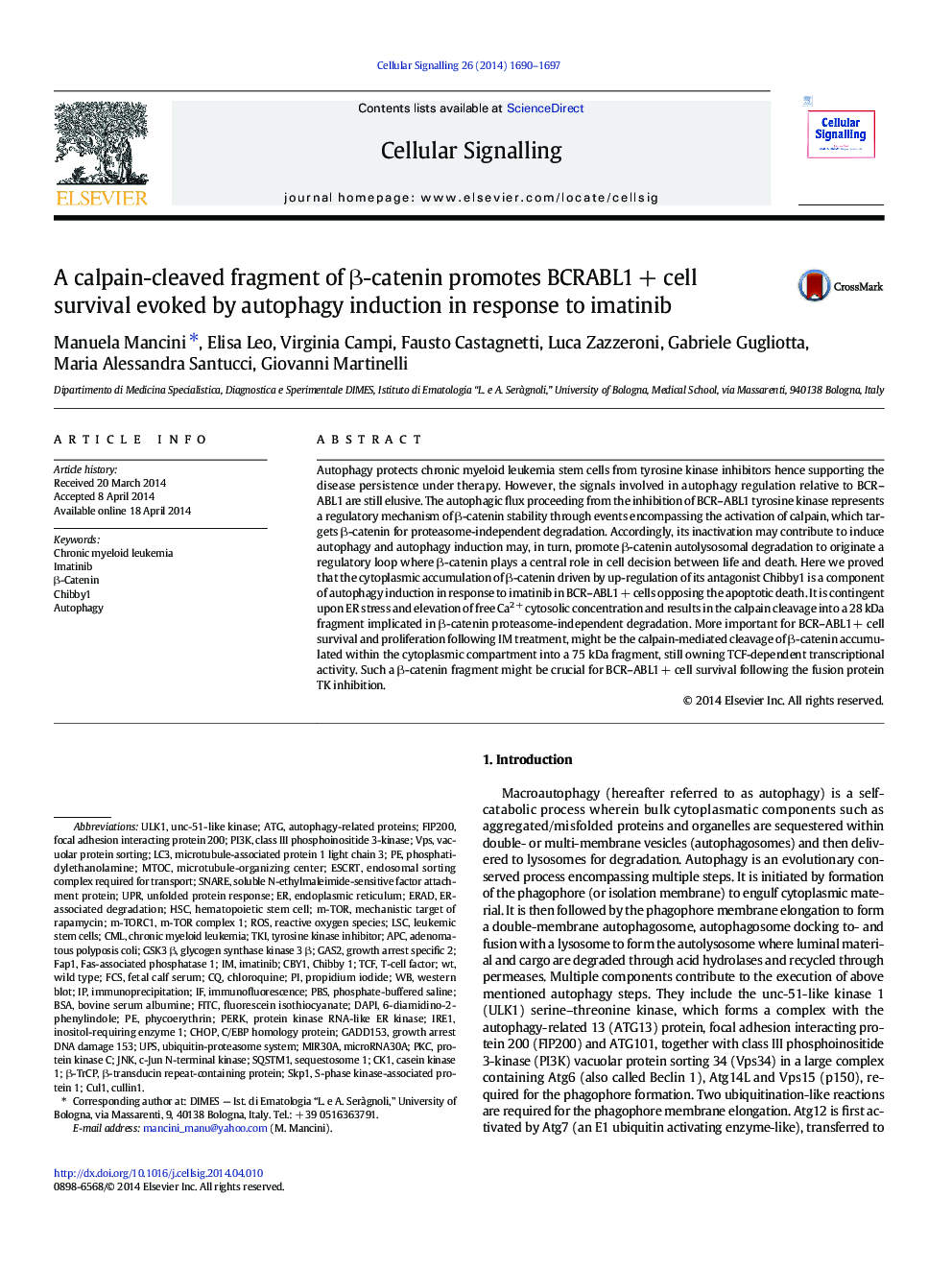| Article ID | Journal | Published Year | Pages | File Type |
|---|---|---|---|---|
| 10816019 | Cellular Signalling | 2014 | 8 Pages |
Abstract
Autophagy protects chronic myeloid leukemia stem cells from tyrosine kinase inhibitors hence supporting the disease persistence under therapy. However, the signals involved in autophagy regulation relative to BCR-ABL1 are still elusive. The autophagic flux proceeding from the inhibition of BCR-ABL1 tyrosine kinase represents a regulatory mechanism of β-catenin stability through events encompassing the activation of calpain, which targets β-catenin for proteasome-independent degradation. Accordingly, its inactivation may contribute to induce autophagy and autophagy induction may, in turn, promote β-catenin autolysosomal degradation to originate a regulatory loop where β-catenin plays a central role in cell decision between life and death. Here we proved that the cytoplasmic accumulation of β-catenin driven by up-regulation of its antagonist Chibby1 is a component of autophagy induction in response to imatinib in BCR-ABL1 + cells opposing the apoptotic death. It is contingent upon ER stress and elevation of free Ca2 + cytosolic concentration and results in the calpain cleavage into a 28 kDa fragment implicated in β-catenin proteasome-independent degradation. More important for BCR-ABL1 + cell survival and proliferation following IM treatment, might be the calpain-mediated cleavage of β-catenin accumulated within the cytoplasmic compartment into a 75 kDa fragment, still owning TCF-dependent transcriptional activity. Such a β-catenin fragment might be crucial for BCR-ABL1 + cell survival following the fusion protein TK inhibition.
Keywords
C/EBP homology proteinULK1TCFESCRTCMLGADD153DAPIAPCTKIFCSMTOCSNAREVPSsoluble N-ethylmaleimide-sensitive factor attachment proteinCK1UPRATGPKCIRE1LC3UNC-51-like kinasePBSHSCLSCJnkPI3KFITCS-PHASE KINASE-ASSOCIATED PROTEIN 1FIP200CUL1Skp1Cullin1ERADm-TORβ-TrCPsequestosome 1SQSTM1GAS26-diamidino-2-phenylindoleBSAc-Jun N-terminal kinaseROSadenomatous polyposis colibovine serum albumineinositol-requiring enzyme 1AutophagyImatinibImmunofluorescenceβ-cateninER-Associated DegradationImmunoprecipitationCHOPfetal calf serumHematopoietic stem cellLeukemic stem cellsUbiquitin-proteasome systemendoplasmic reticulumT-cell factorphycoerythrinphosphatidylethanolaminefluorescein isothiocyanateChronic myeloid leukemiaendosomal sorting complex required for transportPhosphate-buffered salineVacuolar protein sortingmicrotubule-organizing centerTyrosine kinase inhibitorwild typeMechanistic target of rapamycinWestern blotUnfolded protein responseβ-transducin repeat-containing proteinmicrotubule-associated protein 1 light chain 3Autophagy-related proteinsprotein kinase RNA-like ER kinaseProtein kinase CPropidium iodidePERKcasein kinase 1Chloroquineglycogen synthase kinase 3 βReactive oxygen speciesUPS
Related Topics
Life Sciences
Biochemistry, Genetics and Molecular Biology
Biochemistry
Authors
Manuela Mancini, Elisa Leo, Virginia Campi, Fausto Castagnetti, Luca Zazzeroni, Gabriele Gugliotta, Maria Alessandra Santucci, Giovanni Martinelli,
